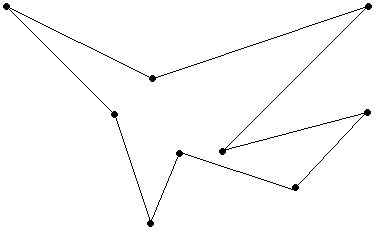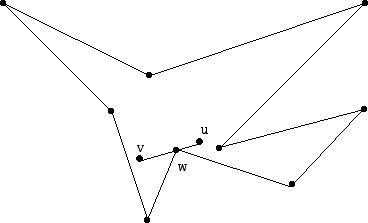prepared by:
Joseph Malkevitch
Department of Mathematics and Computing
York College (CUNY)
Jamaica, New York 11451
Email: malkevitch@york.cuny.edu (for additions, suggestions, and corrections)
web page: www.york.cuny.edu/~malk
Imagine that you are in charge of the security of a military installation in flatland. Buildings in flatland are polygonal such as the one shown below:

One way to provide security is to install point surveillance devices, which have the property that they can see unimpeded provided a wall of the polygon does does not interfere with the line of sight. This suggests the following definition: x of polygon P is visible from a point g (for guard) if the segment gx does not include any points of the exterior of polygon P. Look at the figure below. Note our definition means that a line segment joint two interior points of the polygon P such as the points u and v are visible from each other despite the fact that the segment uv may include a vertex such as w which is on the boundary of the polygon P. This suggests that one might want an alternative notion of visibility, sometimes referred to as clear-visibility. We say that x is clearly visible from y if the segment xy is a subset of the polygon and if the intersection of xy with the boundary of the polygon can include no point or points of the polygon other than x and y themselves.

1. In the diagram above u is visible from v and v is visible from u but u is not clearly visible from v and v is not clearly visible from u. Clear visibility is an interesting and more natural concept for security but mathematically it is easier to work with ordinary visibility. How many guard (points) are need to guard all the polygon P above?
2. a. Can you find a formula, f(n), for the number of guards points that are sometimes necessary and always sufficient to guard all of a polygon with n sides? (Hint: look at how many guards are needed for n =3, n = 4, n = 5, n = 6. By now, perhaps you can find a pattern for the number of guards involved.)
b. How many guards are sufficient for any n-gonal convex polygon?
3. If a polygon can be guarded with g guards, can one always choose g vertices of the polygon which will still serve as guard points for the polygon?
4. What differences would have to made in your analysis of this problem if instead of dealing with visibility one had formulated the problems using clear visibility?
5. Is the following problem the same as the one discussed above:
Given any plane polygon P, determine the minimum number of guards to see all of P?
6. Can you find an algorithm that answers the question above (e.g. 5) quickly?
7. Can you formulate the problem in 2. in a way that might make it possible for a computer program to solve the problem rather than solve it using human eyesight?
8. An interesting variant of the guard problem involves "guarded guards." If a guard might perchance fall asleep, it might be nice to have a collection of guards with the property that a. the guards see all of the polygon and b. for each guard there is some other guard who if that guard appears to be asleep can call him/her on a cell phone! How many guards are needed for our original polygon to solve the "guarded guards" version of the problem? Will you need fewer guards if some of the guards are allowed to be in the interior of the polygon rather than at vertices?